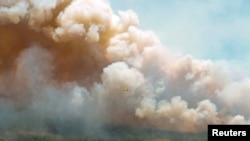Nightmarish orange skies over New York City and Washington this week have made it look like a climate apocalypse is nigh. But is climate change responsible for the wildfires burning in eastern Canada that supplied the smoke? The most that scientists can say at this point is a "definite maybe," according to wildfire expert Mark Cochrane at the University of Maryland.
"This could have happened without climate change," Cochrane said. "On the other hand, because of climate change, more and more often the conditions are there for this sort of event."
The same otherworldly skies have loomed over West Coast cities in recent years as a decadeslong megadrought helped fuel megafires. The drought in the West bears the signature of climate change, scientists say.

But in Quebec, "the signature there is a little bit harder to find, to be honest," said Brian Wiens, managing director of Canada Wildfire, a research partnership between Canadian universities and the government.
"Probably it's climate change, but I wouldn't be prepared to sign my name saying that's definitely it," Wiens added.
Wildfires spread best when it's hot, dry and windy. It has not been extremely dry in Quebec this year, but it has been extremely hot. Parts of Quebec broke temperature records in early June. Then, thunderstorms brought lightning but little rain to the region, sparking the fires. Strong winds fanned the flames.
These conditions are becoming more common as the planet warms, according to research Cochrane and his colleagues conducted.
"Even up in eastern Canada, what we see is a progression to more extreme heat events, more extreme periods without rain," Cochrane said. "That's setting the scene for a potential fire."
Still, the forecast for eastern Canada is to get wetter overall with climate change, which should limit how often wildfires happen.
"Is it going to become as frequent as (in) the West? Not anytime soon," Cochrane said. "But more frequent? Yes."
It's not the first time wildfires in Quebec have smoked out the northeastern United States. It happened in 2010 and 2002.
"It's not unheard-of. It certainly happens from time to time," Wiens said.

As for the hellscape skies over New York and Washington, it wasn't just the wildfires that did it. An unusually stable weather pattern set up an atmospheric pipeline that delivered the smoke south.
"You had a few things that came together there, none of which are that extraordinary," Wiens said. "All ... of them together is what created the amazing, horrible skies that everybody's endured."

"The really remarkable thing is that we've got a significant fire year to the east as well as to the west," he added. More than 400 fires in total are burning across the country, according to the Canadian Interagency Forest Fire Center.
Canadian officials say at this rate the country may see its largest burned area on record this year.
That looks a lot like climate change, Cochrane said.
"In places where there's a lot of fire, we have more fire. But in places where we don't typically think of fire, we now have the ability to have conditions where we have an unprecedented outbreak of fires," he said.
"And we're not prepared in those areas," he added.


